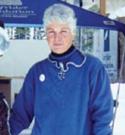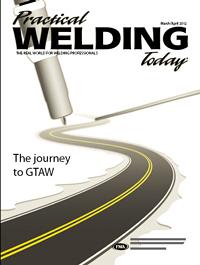- FMA
- The Fabricator
- FABTECH
- Canadian Metalworking
Categories
- Additive Manufacturing
- Aluminum Welding
- Arc Welding
- Assembly and Joining
- Automation and Robotics
- Bending and Forming
- Consumables
- Cutting and Weld Prep
- Electric Vehicles
- En Español
- Finishing
- Hydroforming
- Laser Cutting
- Laser Welding
- Machining
- Manufacturing Software
- Materials Handling
- Metals/Materials
- Oxyfuel Cutting
- Plasma Cutting
- Power Tools
- Punching and Other Holemaking
- Roll Forming
- Safety
- Sawing
- Shearing
- Shop Management
- Testing and Measuring
- Tube and Pipe Fabrication
- Tube and Pipe Production
- Waterjet Cutting
Industry Directory
Webcasts
Podcasts
FAB 40
Advertise
Subscribe
Account Login
Search
Tales of TIG welding
4 unique journeys
- By Amanda Carlson
- March 9, 2012
- Article
- Arc Welding
Whether you call it TIG welding, gas tungsten arc welding (GTAW), or heliarc welding, the truth is every welder’s journey through TIG is different. While some liken it to brain surgery, others call it tedious. Some enjoy the destination, while others get the heck out of Dodge faster than you can contaminate your tungsten.
The process, much like its GMAW, SMAW, and FCAW counterparts, is truly an art form, but it doesn’t suit everyone. As you recall your own personal GTAW journey, here is a look at four very different paths through the process and the lessons they’ve learned along the way.
The Un-TIG Welder
Marty Rice doesn’t mince words. The member of the Iron Workers Local Union 263 and structural welding instructor at a career center in Dallas is confident that he pursued his true calling. Still, he recognizes that he probably should have learned TIG welding a little earlier in life, if only to save him from a few less than desirable situations.
Rice, who wasn’t required to learn TIG in apprentice school, has this to say:
“If you can’t walk and chew gum at the same time, you’re going to have a rough time learning how to TIG weld.”
Rice went back to school to earn his bachelor’s degree after he suffered a work injury. As he was working toward the degree he got a teaching internship with a technical school, which served as a wake-up call.
“The first day out in the shop a guy asked me if I could help him with some TIG welding. So I sat down and pretty much welded worse than he did. And here I am a new instructor.”
But that only made Rice work harder to nail the process. After completing his 10-hour shift, he’d stay at school for another three hours reading and practicing TIG.
“I just drilled myself until I got it down. Being that I had already been in welding for a while, it wasn’t real hard. But it’s a completely different process. It took me about a week to bone on it before I felt confident teaching it again, or teaching it at all.”
Rice, a guy devoted to SMAW, enjoys the freedom to weld outdoors and on top of buildings. For this reason he finds TIG welding a bit constricting. That’s not to say there haven’t been times when he hasn’t peeked over the fence, so to speak.
“When I went to the community college, one of my instructors, a pipe fitter, told me I should learn TIG. He told me that if I did, I’d be a lot better off.
“Well, about seven or eight years later I was working on a power-house and the wind chill was like 40 below zero. I was hanging off of the side of the building about 20 floors up in a basket, just freezing to death. My fingers were so cold that I had to stop and blow into my gloves just to warm them up. I was just miserable.
“You know how sometimes you get the feeling that someone is looking at you? I kind of looked over and there was a big stainless steel pipe with scaffolding, a floor around it, and heavy plastic walls all the way around it. Inside it I could see a heater, a chair, and my old welding instructor. He was standing there with a cup of coffee in his hand and he looked at me—I hadn’t seen him in years—and he mouthed, ‘I told you so!’
“I about fell out of my basket. It was so funny. I’m still glad I became an ironworker, but in that moment I wasn’t.”
Rice’s advice for wannabe TIG welders?
“You really need to relax with TIG. You can see the puddle developing clearly right in front of you, and it’s way more forgiving than other processes. If there’s a place where you’ve messed up, you can go back and fix it.”
The “Both Sides of the Helmet” Welder
Jim Watson’s TIG journey began as a kid on a quest with his dad to get parts made for his minibike. As a kid, the now president and founder of Arc-Zone.com, a supplier of welding accessories, and author of the Joe Welder™ blog loved motorsports, building model airplanes, and customizing bicycles. But as soon as he saw TIG welding up close, he was hooked.
“I needed to have a brake pedal and some other things made [for my bike]. My dad and I searched the phone book and found a local heliarc welder. When we went to the welding shop, the welder was really friendly and he let me look in the back of his hood while he welded. It just looked really cool what he was doing,” Watson said.
As he got older his involvement in motorsports became more serious, as did his interest in welding and fabricating. He had done some SMAW and oxyfuel cutting in middle school shop class, but it wasn’t until one of his sponsors showed him a race car he was building in the back of his motorcycle shop that a serious interest in TIG was triggered. Watson wanted to help fabricate it, but he knew nothing about TIG welding chassis.
“So I went to night school at the local technical college and took welding classes. That’s when I really got turned on to TIG welding. I welded the whole chassis for him.”
And then Watson met the owner of Weldcraft Products, a manufacturer of TIG welding equipment.
“He told me that you can never make a living in racing, so he asked me to come and work for him. I was just out of high school when I started there.”
Watson took a particular interest in the equipment side of TIG on his own as well, creating a torch in his home shop and earning a patent in his name for the shape of the handle as well as a couple of other design features.
“Being on both sides of the helmet has shown me that you’ve got to have the right tools for the job, and they need to be comfortable, flexible, and have the right accessory parts.”
Watson found that the fine motor skills he developed building model airplanes with his father, along with oxyacetylene welding experience, helped make learning TIG a lot easier.
“TIG kind of came naturally to me. I really had already learned the fine motor skills and the hand-eye coordination. You’ve got to have good timing and coordination.”
One of the best pieces of advice Watson received was to get comfortable and to take it slow.
“If you’re inside a tube chassis, for example, whether it’s an aircraft frame or a race car chassis, and you’re welding out of position, getting your torch, rod, and even your helmet in the right position makes a difference.
“Right before I graduated high school my dad and I built our first race car. It was a kit car, and he would man the foot control and I would be inside the tube chassis in position to weld. I would tell him, ‘Step on it!’ and he would always step on it when I didn’t have my hood down.
“I used to go to work with my eyes feeling all sandy from arc flash. This, of course, was before the days of electronic helmets. It was one of those things where it was a real tedious job welding several hundred weld joints on a car like that, so he would get a little anxious and assume, because I was in a certain position, that I was ready to go. So he’d step on that pedal. When that would happen we’d sound a little like the Teutul family from Orange County Choppers, like ‘What are you doing? Not yet!’”
The Aircraft Welder Turned Instructor
As a weld instructor at Rock Valley College, Rockford, Ill., Mike Merriman has to be good at all of the welding processes, but if he had to designate his specialty, it would definitely be TIG.
Welding runs in Merriman’s family: His mother was a ship welder in San Francisco during World War II.
“My dad always joked with her that those were the ships that sank.”
Merriman started welding in 1969. In high school he split his time between the classroom and Mendota Custom Shop, Mendota, Ill., an automobile restoration shop, where he learned how to oxyacetylene weld under shop owner Phil Buland. Eventually he progressed to TIG welding.
These experiences came in handy when he joined the Marines soon after.
“They say never to volunteer for anything in the military. They were looking for volunteers to go to aircraft welding school. Well, the guy didn’t even get to finish his sentence before I volunteered.”
Merriman was sent to Naval Air Station North Island (NASNI), an installation at Naval Base Coronado near San Diego, Calif., where he was immersed in TIG welding on aluminum, stainless steel, and chrome-moly. It was all repair work, so he rarely got to weld on anything clean and new.
And he learned very early the gravity of being an aircraft welder.
“We welded on aircraft, and anytime you weld or repair on an airplane, you’ve got somebody’s life in your hands. I learned to be very meticulous about my TIG welding.
“I can remember as I was learning, my instructor would come up behind me and try to scare me while I was welding; he’d find a piece of pipe, sneak up behind me, and drop it on the floor. Or he’d come up with a 3-pound sledge hammer and hit the bench where I was welding. He’d just scare the hell out of me. When you’re TIG welding, you have to concentrate on that puddle, so every time he’d do that, I’d just bury my tungsten into the weld. But after a month or so of him doing that, it eventually didn’t faze me. He did it to teach me not to be so nervous, and it really helped.”
Like the others, Merriman says the keys to becoming a good TIG welder are learning how to relax and finding a comfortable body position.
Now Merriman helps student welders navigate their own welding paths. He doesn’t sneak up behind them and scare them like his mentor did, but he does make sure to provide constructive feedback, an open door, and a lot of patience.
The “Rock Welder”
Kay Minto describes herself as an explorer, so it makes sense that she found a way to TIG weld lava to create interesting, humorous, or thought-provoking artistic sculptures.
Minto was an art major at a four-year university in Oklahoma when she was first introduced to making metal art with oxyacetylene.
“I was required by the art school to take a class on oxyacetylene. I was really excited because clay is really limiting structurally. Well, I was probably the only woman other than the secretary in this three-story industrial arts building. But I got my certificate.”
Shortly after college, life seemed to take over, and this delayed Minto’s artistic expression for the time being. She got married, moved to a cattle ranch in California, raised a family, and helped her husband with his business.
But a welding class at Lassen Community College, Susanville, Calif., reawakened her creative spirit and introduced her to a process that would forever change the way she approached her art.
Minto had done her homework on TIG welding and was intrigued by what it could offer her art. With the help of instructor John Mulcahy, whom she credits for helping her to feel less intimidated in the classroom and encouraging her to explore TIG welding’s limits, she dove in headfirst and hasn’t looked back since.
“My instructor called it the brain surgery of welding. He had me keep notebooks on my settings and materials. He stood behind me and was so encouraging. I like to explore parameters, so I put a 1⁄16-in. aluminum rod in a vise and laid a bead on that. The ultimate test was laying a bead on a single sheet of aluminum foil.
“Whenever I have an art reception, I love when welders are in the audience because they’re the only ones that really know what I’m talking about and what I’ve attempted to perform in my work.”
So how does one become a rock welder? It was a chance encounter with landscape lava that got the ball rolling. As she picked up one, she started thinking how it would handle the TIG process.
“I had learned that the hard stones like marble and granite don’t react well to the expansion and the contraction with the heat. They flake. But lava rocks have already been fired by Mother Nature. They’re porous, so they handle the expansion and contraction well.”
Through her journey, Minto has become an advocate for TIG welding and vocational training.
“I can honestly say that I have learned more in vocational welding than I did in four years at the university. I learned that there are so many ways to do something. That’s what helped me when I was mulling over how to weld rocks together.
“Anytime I can speak up for going after your dream and learning, I do. By the way, I’m 70 years old.”
About the Author

Amanda Carlson
2135 Point Blvd
Elgin, IL 60123
815-227-8260
Amanda Carlson was named as the editor for The WELDER in January 2017. She is responsible for coordinating and writing or editing all of the magazine’s editorial content. Before joining The WELDER, Amanda was a news editor for two years, coordinating and editing all product and industry news items for several publications and thefabricator.com.
About the Publication
subscribe now

The Welder, formerly known as Practical Welding Today, is a showcase of the real people who make the products we use and work with every day. This magazine has served the welding community in North America well for more than 20 years.
start your free subscription- Stay connected from anywhere

Easily access valuable industry resources now with full access to the digital edition of The Fabricator.

Easily access valuable industry resources now with full access to the digital edition of The Welder.

Easily access valuable industry resources now with full access to the digital edition of The Tube and Pipe Journal.
- Podcasting
- Podcast:
- The Fabricator Podcast
- Published:
- 04/16/2024
- Running Time:
- 63:29
In this episode of The Fabricator Podcast, Caleb Chamberlain, co-founder and CEO of OSH Cut, discusses his company’s...
- Industry Events
16th Annual Safety Conference
- April 30 - May 1, 2024
- Elgin,
Pipe and Tube Conference
- May 21 - 22, 2024
- Omaha, NE
World-Class Roll Forming Workshop
- June 5 - 6, 2024
- Louisville, KY
Advanced Laser Application Workshop
- June 25 - 27, 2024
- Novi, MI




































